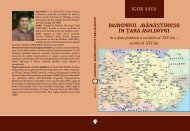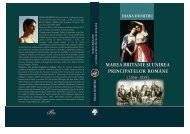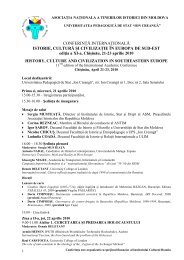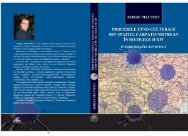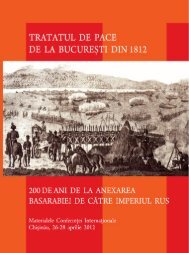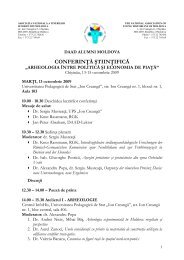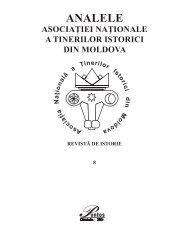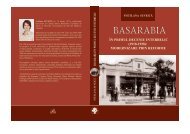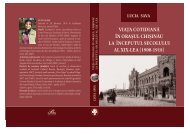Monografia (document PDF) - Asociatia Tinerilor Istorici din Moldova
Monografia (document PDF) - Asociatia Tinerilor Istorici din Moldova
Monografia (document PDF) - Asociatia Tinerilor Istorici din Moldova
Create successful ePaper yourself
Turn your PDF publications into a flip-book with our unique Google optimized e-Paper software.
Presă şi cenzură în Basarabia. Documente şi comentarii<br />
***<br />
Bessarabian press at the beginning of XX th century represents a complex and controversial<br />
reflexion of the events that took place in this area, events that are still difficult to understand for<br />
researchers. Due to socio-political changes occurred after revolution 1905-1907, official press lost<br />
its control over media market of huge Imperia, inclu<strong>din</strong>g Bessarabian province. The evidences<br />
discussed in this paper, identify a large amount of newspapers titles between years 1900-1918<br />
(mostly in Russian language) that belonged to individuals.<br />
The paper represents a synthetic and <strong>document</strong>ary perspective on history of Bessarabian<br />
press in the context of imperial censorship. The phenomenon of press in tsarist imperia cannot be<br />
perceived and studied adequately, if not compared with censorship institutes. Our mission is to<br />
study and highlight the specifics of Bessarabian press at the beginning of XXt h century. We have<br />
some reasons to fix these objectives:<br />
• Lack of historical data about titles of newspapers appeared in Bessarabia between years<br />
1900-1918;<br />
• Identification of <strong>document</strong>ary sources, to identify the volume of information about press’<br />
censorship in Bessarabia at the beginning of XX th century;<br />
• Recognition of special conditions of applying the tsarist censorship law in Bessarabia, on the<br />
basis of Manifest from October, 17, 1905.<br />
***<br />
A history of Bessarabian press is required for knowledge of realities of the past. Current historical<br />
dispute is based on novel <strong>document</strong>al testimonies, which were decoded from local archives<br />
as well as from those of former Empire (Russian\Soviet), most of these archives become accessible<br />
only after 1989. A history of Bessarabian press is required for knowledge of realities of the past.<br />
The history of bessarabian press from XIXth century – beginnings of XXth is mostly a history of<br />
official press of Tsarist administration, written in Russian language: Bessarabskie Oblastnye Vedomosti<br />
(1854-1873), then Gubernskie Vedomosti (1871-1916); Bessarabskii Vestnik (1889-1898).<br />
Only clerical press made an exception in this sense: for a short period, Kisinevskie Eparhialinye<br />
Vedomosti (1867-1872) was edited in Romanian.<br />
For fifty years – from the fourth decade of XIXth century – Tsarist censorship thwarted 7-8<br />
attempts of Bessarabian noblemen to build a national press. The efforts of these noblemen were<br />
beneficial for posterity, and unleashed, at the beginnings of XXth century, an extraor<strong>din</strong>ary frame<br />
of mind for ideas of social and national emancipation. In absence of own political organizations,<br />
journalist activity became the main form of manifestation of national movement. The framework<br />
for strategy of Bessarabia’s renaissance movement was elaborated through the national publications.<br />
In spite of all restrictions and persecutions, a considerable number of publications in Romanian<br />
language appeared in the course of one decade: Basarabia(1905); Basarabia(1906 – 1907);<br />
Viaţa Basarabiei (1907); Basarabia Reînnoită(1907); <strong>Moldova</strong>nul (1907 – 1908); Luminătorul (1908<br />
– 1917); Lira Basarabiei (1912); Făclia Ţării (1912); Glasul Basarabiei (1913 – 1914); Cuvânt Moldovenesc<br />
review (1913 – 1914); the newspaper Cuvânt Moldovenesc (1914 – 1917); Şcoala Moldovenească<br />
(1917); Soldatul Moldovean (1917); Pământ şi Voie (1917); Sfatul Ţării (1917).<br />
The Romanian press from the beginnings of XXth century was a decisive factor in the struggle<br />
for national awakening of Bessarabians and for liberation from despotic regime of Russian autocracy.<br />
The chances for consolidation of Bessarabian press were valuated after 1918 when Bessarabia<br />
became a part of Romanian state. Press was the only chance for cultural personalities and<br />
for young talents to be heard, so all ideas and literary trends was explained and discussed in press.<br />
– 145 –



